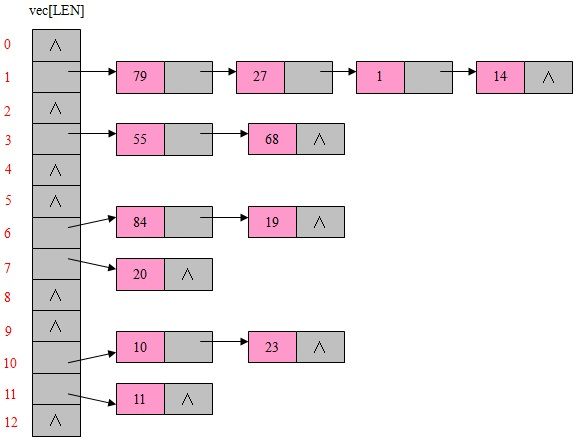散列表的基本概念及其运算
参考文献: 《数据结构(C语言版)》 严蔚敏 吴伟民 编著
开发平台:Ubuntu11.04
编译器:gcc version4.5.2 (Ubuntu/Linaro 4.5.2-8ubuntu4)
散列表(也叫哈希表)是一种查找算法,与链表、树等算法不同的是,散列表算法在查找时不需要进行一系列和关键字(关键字是数据元素中某个数据项的值,用以标识一个数据元素)的比较操作。
散列表算法希望能尽量做到不经过任何比较,通过一次存取就能得到所查找的数据元素,因而必须要在数据元素的存储位置和它的关键字(可用key表示)之间建立一个确定的对应关系,使每个关键字和散列表中一个唯一的存储位置相对应。因此在查找时,只要根据这个对应关系找到给定关键字在散列表中的位置即可。这种对应关系被称为散列函数(可用h(key)表示)。
根据设定的散列函数h(key)和处理冲突的方法将一组关键字key映像到一个有限的连续的地址区间上,并以关键字在地址区间中的像作为数据元素在表中的存储位置,这种表便被称为散列表,这一映像过程称为散列,所得存储位置称为散列地址。
关键字、散列函数以及散列表的关系如下图所示:
1、散列函数
散列函数是从关键字到地址区间的映像。
好的散列函数能够使得关键字经过散列后得到一个随机的地址,以便使一组关键字的散列地址均匀地分布在整个地址区间中,从而减少冲突。
常用的构造散列函数的方法有:
(1)、直接定址法
取关键字或关键字的某个线性函数值为散列地址,即:
h(key) = key 或 h(key) = a * key + b
其中a和b为常数。
(2)、数字分析法
(3)、平方取值法
取关键字平方后的中间几位为散列地址。
(4)、折叠法
将关键字分割成位数相同的几部分(最后一部分的位数可以不同),然后取这几部分的叠加和(舍去进位)作为散列地址。
(5)、除留余数法
取关键字被某个不大于散列表表长m的数p除后所得的余数为散列地址,即:
h(key) = key MOD p p ≤ m
(6)、随机数法
选择一个随机函数,取关键字的随机函数值为它的散列地址,即:
h(key) = random(key)
其中random为随机函数。
2、处理冲突
对不同的关键字可能得到同一散列地址,即key1 ≠ key2,而h(key1)= h(key2),这种现象称为冲突。具有相同函数值的关键字对该散列函数来说称作同义词。
在一般情况下,散列函数是一个压缩映像,这就不可避免地会产生冲突,因此,在创建散列表时不仅要设定一个好的散列函数,而且还要设定一种处理冲突的方法。
常用的处理冲突的方法有:
(1)、开放定址法
hi =(h(key) + di) MOD m i =1,2,…,k(k ≤ m-1)
其中,h(key)为散列函数,m为散列表表长,di为增量序列,可有下列三种取法:
1)、di = 1,2,3,…,m-1,称线性探测再散列;
2)、di = 12,-12,22,-22,32,…,±k2 (k ≤m/2),称二次探测再散列;
3)、di = 伪随机数序列,称伪随机探测再散列。
(2)、再散列法
hi = rhi(key) i = 1,2,…,k
rhi均是不同的散列函数。
(3)、链地址法
将所有关键字为同义词的数据元素存储在同一线性链表中。假设某散列函数产生的散列地址在区间[0,m-1]上,则设立一个指针型向量void *vec[m],其每个分量的初始状态都是空指针。凡散列地址为i的数据元素都插入到头指针为vec[i]的链表中。在链表中的插入位置可以在表头或表尾,也可以在表的中间,以保持同义词在同一线性链表中按关键字有序排列。
(4)、建立一个公共溢出区
例子以除留余数法和链地址法构造散列表,共用代码如下:
#include
#include
#define LEN 13
struct hash_node {
int count;
struct hash_node *next;
};
static int hash(int num)
{
return num % LEN;
}
static void collision(struct hash_node *vec[], int elem, struct hash_node *new)
{
if (vec[elem] == NULL)
vec[elem] = new;
else
{
new -> next = vec[elem];
vec[elem] = new;
}
}
static void ord_num_print(int i)
{
if (i == 1)
printf("the 1st element: ");
else if (i == 2)
printf("the 2nd element: ");
else if (i == 3)
printf("the 3rd element: ");
else
printf("the %dth element: ", i);
}
static void print_hash(struct hash_node *vec[])
{
int i;
struct hash_node *tmp;
for (i = 0; i < LEN; i++)
if (vec[i] == NULL)
{
ord_num_print(i+1);
printf("NULL\n");
}
else
{
ord_num_print(i+1);
tmp = vec[i];
do {
printf("%d ", tmp->count);
}while ((tmp = tmp->next) && tmp != NULL);
printf("\n");
}
}
static void create_hash(struct hash_node *vec[], int num)
{
FILE *fp;
int i, tmp, arr[num];
struct hash_node *p;
fp = fopen("./hash", "r");
for (i = 0; i < num; i++)
fscanf(fp, "%d", &arr[i]);
fclose(fp);
for (i = 0; i < num; i++) {
p = malloc(sizeof(struct hash_node));
p -> count = arr[i];
p -> next = NULL;
tmp = hash(arr[i]);
collision(vec, tmp, p);
}
} 其中,hash是散列函数,collision函数用于处理冲突。
create_hash函数通过读取./hash文件中的num个关键字来构建一个散列表。例子中hash文件的内容如下:
19 14 23 01 68 20 84 27 55 11 10 79
3、元素插入
void insert_hash_node(struct hash_node *vec[], int data)
{
int tmp;
struct hash_node *p = malloc(sizeof(struct hash_node));
p -> count = data;
p -> next = NULL;
tmp = hash(data);
collision(vec, tmp, p);
}4、元素删除
void delete_hash_node(struct hash_node *vec[], int data)
{
int elem;
struct hash_node *p, *tmp;
elem = hash(data);
if (vec[elem] == NULL) {
fprintf(stderr, "vec[%d] is NULL\n", elem);
exit(-2);
}
else
{
tmp = vec[elem];
while (tmp -> count != data) {
if (tmp -> next == NULL) {
fprintf(stderr, "not found %d\n", data);
exit(-3);
}
p = tmp;
tmp = tmp -> next;
}
p -> next = tmp -> next;
free(tmp);
}
}在main函数中,通过三步来验证上述所列的各种函数,第一步调用create_hash函数创建一个具有12个关键字的散列表(见下图),第二步插入关键字29,第三步删除关键字1。
int main(int argc, char *argv[])
{
int i, num;
struct hash_node *vec[LEN];
/* num, the number of integers in the ./hash file */
if (argc < 2) {
fprintf(stderr, "Usage: %s num\n", argv[0]);
exit(-1);
}
for (i = 0; i < LEN; i++)
vec[i] = NULL;
num = atoi(argv[1]);
printf("\tthe first times\n");
create_hash(vec, num);
print_hash(vec);
printf("\n\tthe second times\n");
insert_hash_node(vec, 29);
print_hash(vec);
printf("\n\tthe third times\n");
delete_hash_node(vec, 1);
print_hash(vec);
return 0;
}
执行和输出结果:
$ ./hash_list 12 the first times
the 1st element: NULL
the 2nd element: 79 27 1 14
the 3rd element: NULL
the 4th element: 55 68
the 5th element: NULL
the 6th element: NULL
the 7th element: 84 19
the 8th element: 20
the 9th element: NULL
the 10th element: NULL
the 11th element: 10 23
the 12th element: 11
the 13th element: NULL
the second times
the 1st element: NULL
the 2nd element: 79 27 1 14
the 3rd element: NULL
the 4th element: 29 55 68
the 5th element: NULL
the 6th element: NULL
the 7th element: 84 19
the 8th element: 20
the 9th element: NULL
the 10th element: NULL
the 11th element: 10 23
the 12th element: 11
the 13th element: NULL
the third times
the 1st element: NULL
the 2nd element: 79 27 14
the 3rd element: NULL
the 4th element: 29 55 68
the 5th element: NULL
the 6th element: NULL
the 7th element: 84 19
the 8th element: 20
the 9th element: NULL
the 10th element: NULL
the 11th element: 10 23
the 12th element: 11
the 13th element: NULL
